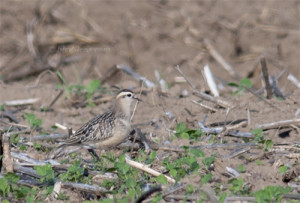 The Eurasian dotterel (Charadrius morinellus) is a member of the plover family which migrates from northern Europe, where it breeds, to North Africa, where it winters. In the Middle Rhine area (Rhineland-Palatinate and Hesse) the Eurasian dotterel was considered to be a rare vagrant until recently. Only through systematic migration surveys, a large number of records were discovered of this species. The (re)discovery required the migration status to be set by Rhineland-Palatinate ornithologists from ‘accidentally’ to ‘regular passage’. The main migration period is during late August and early September. But observations are both from return migration as well as from the fall migration to the wintering areas. Springtime observations are significantly less often counted than the fall findings. Spring migration occurs during the period between mid-April to mid-May. The species prefers open habitats in elevated locations like hilly plateaus. Only rarely the pretty small Eurasian Dotterel be discovered by accident. The Eurasian Dotterel (Charadrius morinellus) shows a strong preference for grubbed stubble fields. In the following years of a initial rediscovery numerous similar observations could be made.
The Eurasian dotterel (Charadrius morinellus) is a member of the plover family which migrates from northern Europe, where it breeds, to North Africa, where it winters. In the Middle Rhine area (Rhineland-Palatinate and Hesse) the Eurasian dotterel was considered to be a rare vagrant until recently. Only through systematic migration surveys, a large number of records were discovered of this species. The (re)discovery required the migration status to be set by Rhineland-Palatinate ornithologists from ‘accidentally’ to ‘regular passage’. The main migration period is during late August and early September. But observations are both from return migration as well as from the fall migration to the wintering areas. Springtime observations are significantly less often counted than the fall findings. Spring migration occurs during the period between mid-April to mid-May. The species prefers open habitats in elevated locations like hilly plateaus. Only rarely the pretty small Eurasian Dotterel be discovered by accident. The Eurasian Dotterel (Charadrius morinellus) shows a strong preference for grubbed stubble fields. In the following years of a initial rediscovery numerous similar observations could be made.
Albeit only a few birds were found by targeted search on fields. The exact screening of suitable areas with binoculars or spotting scope usually results only with a lot of time and patience in success. Due to the excellent camouflage of the resting birds – especially when it comes to individual specimens – are much more difficult to detect as migrants. Once you have discovered a Dotterel, it is relatively easy to determine the ID-characteristics and a Dotterel can hardly be confused with other species. There is a high dynamic range at the rest areas. Many birds descend and dwell only briefly. Knowing the vocalizations is extremely helpful. When landing and flying off a trilling call, a melancholy “pjurrr” is often expressed. Eurasian Dotterel rest mainly in groups mostly of this species. Only rarely they mix with other waders (e.g. European Golden-Plover (Pluvialis apricaria)). In a staging area they often behave quite familiar and usually persist even on a few meters distance. However, larger flocks are sometimes shy and fly away even in case of low interference.
A good procedure is to get familiar with the calls of the Dotterel, stay in the right location in the right time of the year and to catch birds that call in flight before landing. Main threats are habitat destruction due to erection of vertical structures as farm buildings, pylons of power lines and wind turbines and disturbances through recreational acitivities.
A good area to look for Eurasian Dotterels in the right time of the year, is in the hilly landscape near Frankfurt. There are many airlines which use the Airport of Frankfurt/ Main, the international hub for Germany, and drive with a rented car in roughly 1 hour to Partenheim and Ober-Hilbersheim close to state capital Mainz. While waiting for migrating waders you can enjoy the landscape with a breathtaking view to the north-east towards the Rhine valley.
An alternative might be to look for Eurasian Dotterels in the Algarve. Eurasian Dotterels is a regular passage migrant for many years, mainly in the Sagres Peninsula. The flat fields of Vale Santo are the main area of occurrence of this tundra bird, which likes the steppe. It can be seen there with roughly a 3 weeks delay compared to the german staggering sites every year between September and October.
To cope with the growing demand for top shots of the rarer species of the Palearctic Bird-Lens.com is keen to enrich the range of pictures of birds you can find in the western palearctic. Trips to productive locations in Germany but also to remote places in the world to capture images of rare birds of western palearctic were very successful. The nice image of the blog was shot on the plateau of the Maifeld in the Eifel hills near Koblenz in Germany and is only a first impression, what you will find in the gallery in the “Picture Shop” very soon. Just give a message, if bird-lens.com could serve you with an image needed before the new pictures are online.